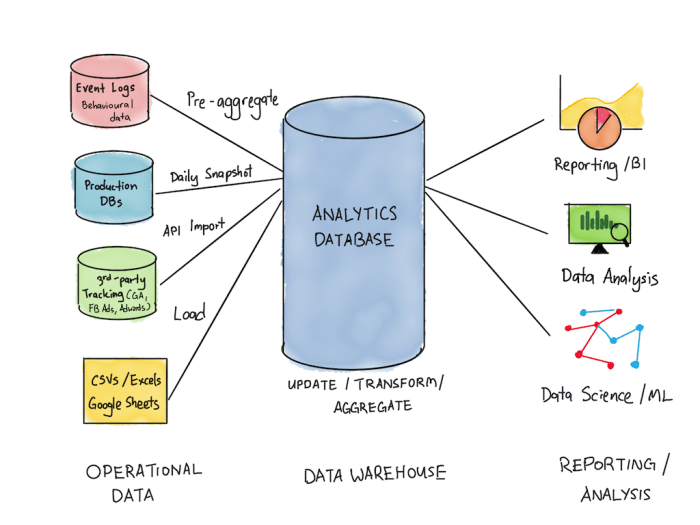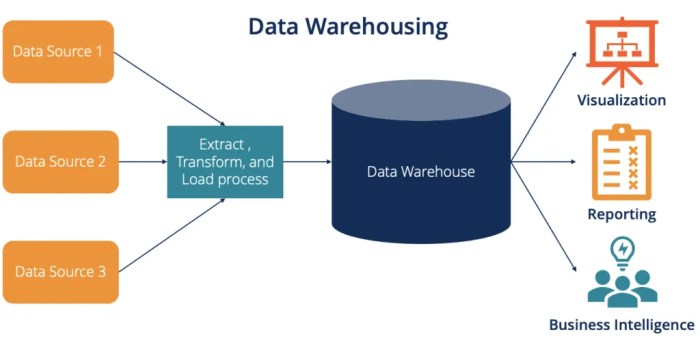Introducing the realm of database systems: introduction to databases and data warehouses, this comprehensive guide embarks on an enlightening journey into the world of data management. From the fundamentals of databases to the intricacies of data warehouses, this exploration delves into the core concepts and practical applications that shape the landscape of modern data management.
As we navigate through this discourse, we will uncover the essential components of databases, unravel the diverse types of databases that cater to different data needs, and delve into the role of database management systems (DBMS) in orchestrating data access and manipulation.
Furthermore, we will explore the principles of data modeling, shedding light on the techniques used to structure and organize data for efficient retrieval and analysis.
Introduction to Databases
A database is a structured collection of data that is organized and stored in a way that allows for efficient retrieval and management. It consists of interrelated data items, typically stored in tables or other data structures.
Databases provide numerous benefits, including:
- Centralized data storage and management
- Improved data consistency and integrity
- Enhanced data security and access control
- Facilitated data analysis and reporting
Databases are widely used in various domains, such as:
- Business applications (e.g., customer relationship management, inventory management)
- Scientific research (e.g., storing experimental data, managing research projects)
- Government (e.g., maintaining citizen records, tracking public health data)
- Healthcare (e.g., storing patient medical records, managing appointments)
Types of Databases
There are different types of databases, each with its own characteristics and use cases:
- Relational databases: Store data in tables with rows and columns, and enforce relationships between data using primary and foreign keys.
- NoSQL databases: Non-relational databases that do not follow the strict structure of relational databases, offering flexibility and scalability for specific data types.
Database Management Systems (DBMS)
A database management system (DBMS) is a software system that provides the tools and functionality for creating, managing, and accessing databases.
Functions of a DBMS, Database systems: introduction to databases and data warehouses
Key functions of a DBMS include:
- Data definition (creating and modifying database structures)
- Data manipulation (inserting, updating, and deleting data)
- Data querying (retrieving data from the database)
- Data security and access control
- Data backup and recovery
Architecture of a DBMS
A DBMS typically consists of several components:
- Database engine: The core component that manages data storage, retrieval, and processing.
- Query processor: Translates user queries into instructions that the database engine can execute.
- Transaction manager: Ensures data integrity by managing transactions (sequences of database operations).
- Concurrency control: Manages simultaneous access to data by multiple users.
- Security manager: Enforces access control and data protection measures.
Data Modeling

Data modeling is the process of creating a logical representation of data, capturing its structure and relationships.
Principles of Data Modeling
Key principles of data modeling include:
- Data abstraction: Representing data at a high level, hiding implementation details.
- Data normalization: Structuring data to eliminate redundancies and ensure data integrity.
- Entity-relationship modeling (ERM): A graphical technique for representing entities and their relationships.
Types of Data Models
Common data models include:
- Entity-relationship diagrams (ERDs): Graphical representations of entities and their relationships.
- Relational models: Data organized in tables with rows and columns, connected by relationships.
Data Warehouses

A data warehouse is a central repository of data extracted from various sources, designed for data analysis and reporting.
Benefits of Data Warehouses
Data warehouses offer several benefits:
- Centralized data source: Consolidating data from multiple systems for comprehensive analysis.
- Historical data storage: Preserving data over time for trend analysis and forecasting.
- Improved data quality: Ensuring data accuracy and consistency through data cleansing and transformation.
- Enhanced data accessibility: Providing easy access to data for business intelligence and reporting.
Building a Data Warehouse
Building a data warehouse involves several steps:
- Data extraction: Gathering data from various sources.
- Data transformation: Cleaning, transforming, and integrating data into a consistent format.
- Data loading: Populating the data warehouse with transformed data.
- Data management: Maintaining the data warehouse, ensuring data quality and integrity.
Data Analysis and Reporting
Databases play a crucial role in data analysis and reporting.
Data Analysis
Databases enable data analysis by providing:
- Data querying: Retrieving data using Structured Query Language (SQL) or other query languages.
- Data aggregation: Summarizing data using functions like SUM, COUNT, and AVERAGE.
- Data visualization: Generating charts, graphs, and other visual representations of data.
Data Reporting
Databases support data reporting by:
- Report generation: Creating formatted reports based on data queries.
- Data distribution: Delivering reports to users in various formats (e.g., PDF, Excel).
- Interactive reporting: Allowing users to explore data and generate customized reports.
Database Design and Optimization

Database design involves creating an efficient and scalable database structure.
Principles of Database Design
Key principles of database design include:
- Normalization: Eliminating data redundancy and ensuring data integrity.
- Indexing: Creating indexes on frequently accessed data for faster retrieval.
- Denormalization: Occasionally sacrificing normalization for improved performance in specific scenarios.
Database Optimization
Database optimization techniques include:
- Query optimization: Tuning queries to improve performance.
- Hardware optimization: Using appropriate hardware resources (e.g., memory, CPU) for database operations.
- Database maintenance: Regularly cleaning up and reorganizing data to enhance performance.
Data Security and Privacy: Database Systems: Introduction To Databases And Data Warehouses

Protecting data in databases is crucial for maintaining data integrity and privacy.
Data Security Measures
Data security measures include:
- Encryption: Encrypting data to protect it from unauthorized access.
- Access control: Restricting access to data based on user roles and permissions.
- Data masking: Hiding sensitive data from unauthorized users.
Data Privacy Best Practices
Best practices for data privacy include:
- Data minimization: Collecting only necessary data.
- Data retention: Retaining data only for as long as required.
- Data disposal: Securely disposing of data when no longer needed.
FAQ Section
What are the key components of a database?
A database comprises several key components, including tables, rows, columns, fields, and indexes. Tables serve as the primary data storage units, organized into rows and columns. Fields represent individual data elements within a row, while indexes facilitate efficient data retrieval.
What are the different types of databases?
The database landscape encompasses a diverse range of database types, each tailored to specific data requirements. Relational databases, such as MySQL and Oracle, adhere to the relational model, organizing data into tables with defined relationships. NoSQL databases, on the other hand, offer flexibility and scalability for managing unstructured or semi-structured data.
What is the role of a database management system (DBMS)?
A DBMS acts as the intermediary between users and the database, managing data access, storage, and retrieval. It provides a structured environment for data manipulation, ensuring data integrity, security, and efficient performance.